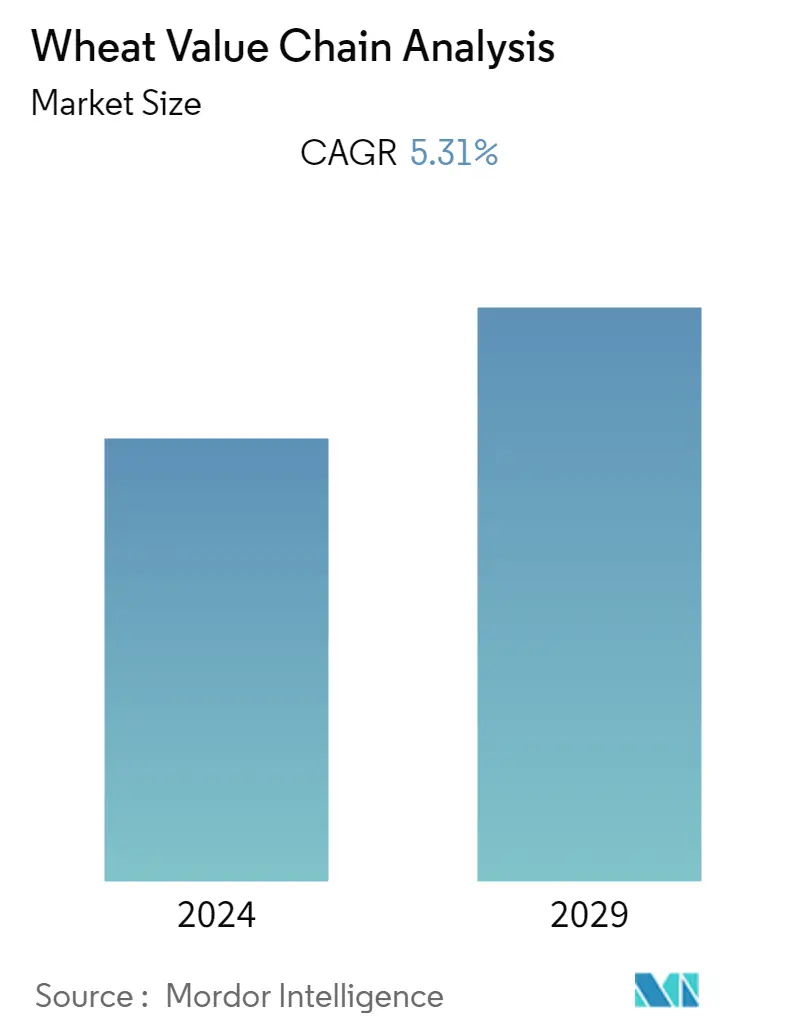Market Size of Wheat Value Chain Analysis

| Study Period | 2019 - 2029 |
| Base Year For Estimation | 2023 |
| Forecast Data Period | 2024 - 2029 |
| CAGR | 5.31 % |
| Fastest Growing Market | Asia-Pacific |
| Largest Market | Asia-Pacific |
Wheat Market Analysis
The Wheat Market size is estimated at USD 161.12 billion in 2023, and is expected to reach USD 208.69 billion by 2028, growing at a CAGR of 5.31% during the forecast period (2023-2028).
- Wheat is one of the key global commodities in terms of acreage and tradeable value and is a staple in household diets. Many factors affect wheat prices, including climate, yields, oil prices, lagged prices, and imports. In addition to gradually and consistently increasing global wheat demand, these market drivers are posited to impact world prices and food security.
- Approximately 21% of the world's food depends on annual wheat crop harvests, which often have relatively low stocks. The developing countries, mostly net wheat importers, consume 77% of the total global wheat production. Accordingly, wheat accounts for approximately 24% of food commodities imported by developing countries.
- The wheat market is much more dispersed than other grain markets, and the countries of the former Soviet Union represent a relatively small share of that market. Hence, the wheat trade restrictions result in a 4% increase in global prices. Wheat has seen a minimal direct impact from the outbreak of the pandemic across the world. As an essential food alongside its staple by-products, flour and bread, any price change minimally affects the demand.
- Countries like the United States, Canada, Australia, China, France, and Russia are major players worldwide in intense wheat trade activities. Hence, over the long term, the increased food security, focus on trade initiatives, and increased participation of the major producing countries are anticipated to drive the growth of the wheat market during the forecast period.
Wheat Industry Segmentation
Wheat is a cereal grass of the genus Triticum and family Poaceae, cultivated widely for its seed and cereal grain, which is the major staple food in the region. The many species of wheat together make up the genus Triticum, out of which the most widely grown is common wheat (Triticum aestivum). The other major varieties are durum wheat (T. durum) and club wheat (T.compactum).
The wheat value chain analysis report offers the value chain overview, price markups in the value chain, stakeholder analysis, and issues and challenges in the value chain.
The market sizing has been done in value terms in USD for all the abovementioned segments.
Wheat Value Chain Analysis Size Summary
The wheat market is a crucial component of the global agricultural landscape, characterized by its extensive acreage and significant tradeable value. As a staple in household diets, wheat's market dynamics are influenced by various factors, including climate conditions, yield variations, oil prices, and import levels. The demand for wheat is steadily increasing worldwide, driven by its role as a primary food source, with developing countries being the largest consumers and importers. The market is relatively dispersed, with major producing countries such as the United States, Canada, Australia, China, France, and Russia playing pivotal roles in global trade. Despite challenges like trade restrictions and geopolitical tensions, the wheat market is expected to experience growth, supported by enhanced food security measures and trade initiatives.
Wheat production is widespread, with significant contributions from Asia-Pacific, European, and North American countries. The crop's adaptability to diverse environmental conditions makes it a leading grain for human consumption. In regions like India and China, government policies and favorable conditions have spurred increased production. However, global events, such as the Ukraine war, have impacted export flows from key producing regions, highlighting the market's sensitivity to geopolitical factors. The rising demand for wheat-based foods, particularly in Asia, underscores the crop's growing importance in global diets. As domestic and international demand continues to rise, the wheat market is poised for further expansion during the forecast period.
Wheat Value Chain Analysis Market Size - Table of Contents
-
1. MARKET DYNAMICS
-
1.1 Value Chain Analysis
-
1.1.1 Value Chain Overview
-
1.1.2 Price Mark Ups in the Value Chain
-
1.1.3 Stakeholder Analysis
-
1.1.4 Issues and Challenges in the Value Chain
-
-
Wheat Value Chain Analysis Market Size FAQs
What is the current Wheat Market size?
The Wheat Market is projected to register a CAGR of 5.31% during the forecast period (2024-2029)
Which is the fastest growing region in Wheat Market?
Asia-Pacific is estimated to grow at the highest CAGR over the forecast period (2024-2029).

